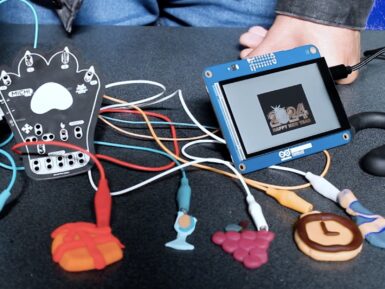
NFC/RFID reader with two transponders
NFC/RFID reader/writer with 1 status LED, antenna integrated on PCB, I²C, SPI, and HSU (High Speed UART) communication interface
Overview
It can function as an RFID card reader/writer, NFC reader with Android smartphone and in wireless mode with two identical devices.
It can be used with Arduino to create access control devices.
The package includes the reader, a keychain transponder, a card transponder and connection cables.
Tech specs
- Power supply: from 3.3 V to 5 V
- Compact and easy to integrate into your project
- Supports interface: I²C, SPI and HSU (High Speed UART), selectable via dip-switch
- Supports RFID read/write, P2P communication between two identical modules, NFC with Android smartphone
- Supports RFID read/write:
- Mifare 1k, 4k, Ultralight, and DesFire cards
- ISO/IEC 14443-4 cards such as CD97BX, CD light, Desfire, P5CN072 (SMX)
- Innovision Jewel cards such as IRT5001 card
- FeliCa cards such as RCS_860 and RCS_854 - Reading distance (mm): max. 50-70
- Dimensions (mm): 43x41x4
Conformities
Get Inspired

Display real-time meeting room availability, synchronized with Google Calendar through Arduino IoT Cloud.

Watching back a slideshow of some of your favorite times of the past years is a great way to reflect on what’s happened and get excited for the future. The Electronic Cats crew wanted to incorporate this concept into a more simplified, interactive form which resulted in the Garrita project. Garrita is a homemade platform that lets an Arduino GIGA R1 WiFi with GIGA Display Shield transform into a highly mobile slideshow thanks to its larger onboard memory capacity and convenient layout. This year, the Electronic Cats were able to take their image shifter concept even further with Michi: an existing project that turns any conductive object into a capacitive touch-sensing controller. Whenever one of Michi’s inputs are toggled, the board sends a signal to the GIGA R1 WiFi that causes the current slide to advance to the next one. In order to go from a locally stored image to something on the Display Shield, users first transform their images into a more suitable format via the LVGL conversion tool. Once downloaded, the resulting files can be easily bundled into a Sketch before they become accessible in the application code. To see more about how the Electronic Cats built Garrita, you can read their write-up here on Hackster.io.








